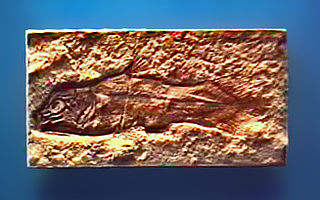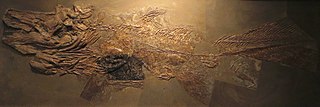
Coelacanths are an ancient group of lobe-finned fish (Sarcopterygii) in the class Actinistia. As sarcopterygians, they are more closely related to lungfish and tetrapods than to ray-finned fish.

Chinlea is an extinct genus of late Triassic Mawsoniid coelacanth fish found in and named after the Chinle Formation that crops out in the southwestern states of Arizona and New Mexico. The word “Chinle” comes from the Navajo word meaning "flowing out", referencing the location where water flows out of the Canyon de Chelly. They were also possibly found in the Dockum Group.

Latimeriidae is the only extant family of coelacanths, an ancient lineage of lobe-finned fish. It contains two extant species in the genus Latimeria, found in deep waters off the coasts of southern Africa and east-central Indonesia. In addition, several fossil genera are known from the Mesozoic of Europe, the Middle East, and the southeastern United States, dating back to the Triassic.
Paleontology or palaeontology is the study of prehistoric life forms on Earth through the examination of plant and animal fossils. This includes the study of body fossils, tracks (ichnites), burrows, cast-off parts, fossilised feces (coprolites), palynomorphs and chemical residues. Because humans have encountered fossils for millennia, paleontology has a long history both before and after becoming formalized as a science. This article records significant discoveries and events related to paleontology that occurred or were published in the year 1994.

Axelrodichthys is an extinct genus of mawsoniid coelacanth from the Cretaceous of Africa, North and South America, and Europe. Several species are known, the remains of which were discovered in the Lower Cretaceous (Aptian-Albian) of Brazil, North Africa, and possibly Mexico, as well as in the Upper Cretaceous of Morocco (Cenomanian), Madagascar and France. The Axelrodichthys of the Lower Cretaceous frequented both brackish and coastal marine waters while the most recent species lived exclusively in fresh waters. The French specimens are the last known fresh water coelacanths. Most of the species of this genus reached 1 metre to 2 metres in length. Axelrodichthys was named in 1986 by John G. Maisey in honor of the American ichthyologist Herbert R. Axelrod.

Acanthomorpha is an extraordinarily diverse taxon of teleost fishes with spiny fin rays. The clade contains about one-third of the world's modern species of vertebrates: over 14,000 species.
Laugia is an extinct genus of coelacanth fish which lived during the Induan age of the Early Triassic epoch in what is now Greenland. The type and only species, Laugia groenlandica, was collected from the Wordie Creek Formation and described by Erik Stensiö. The genus is named after Lauge Koch.

Mawsonia is an extinct genus of prehistoric coelacanth fish. It is amongst the largest of all coelacanths, with one quadrate specimen possibly belonging to an individual measuring 5.3 metres in length. It lived in freshwater and brackish environments from the late Jurassic to the mid-Cretaceous of South America, eastern North America, and Africa. Mawsonia was first described by British paleontologist Arthur Smith Woodward in 1907.

Holophagus is an extinct genus of coelacanth belonging to Latimeriidae. The type species, Holophagus gulo, is known from the Lower Jurassic marine Lias of England. Some authors have considered the genus restricted to the Lias of England.

Mawsoniidae is an extinct family of prehistoric coelacanth fishes which lived during the Triassic to Cretaceous periods. Members of the family are distinguished from their sister group, the Latimeriidae by the presence of ossified ribs, a coarse rugose texture on the dermatocranium and cheek bones, the absence of the suboperculum and the spiracular, and reduction or loss of the descending process of the supratemporal. Mawsoniids are known from North America, Europe, South America, Africa, Madagascar and Asia. Unlike Latimeriidae, which are exclusively marine, Mawsoniidae were also native to freshwater and brackish environments. Mawsoniids represent among the youngest known coelacanths, with the youngest known remains of the freshwater genus Axelrodichthys from France and an indeterminate marine species from Morocco being from the final stage of the Cretaceous, the Maastrichtian, roughly equivalent in age to the youngest known fossils of latimeriids. Species of Mawsonia and Trachymetopon are known to have exceeded 5 metres in length, making them among the largest known bony fish to have ever existed.

Laugiidae is an extinct family of prehistoric lobe-finned fishes which lived during the Triassic and Jurassic periods. Their fossils has been found in Canada, China, Germany and Greenland.
The Demopolis Chalk is a geological formation in North America, within the U.S. states of Alabama, Mississippi, and Tennessee. The chalk was formed by pelagic sediments deposited along the eastern edge of the Mississippi embayment during the middle Campanian stage of the Late Cretaceous. It is a unit of the Selma Group and consists of the upper Bluffport Marl Member and a lower unnamed member. Dinosaur and mosasaur remains are among the fossils that have been recovered from the Demopolis Chalk.
Swenzia is an extinct genus of coelacanthid fish from the late Jurassic of France. It contains a single species, S. latimerae, which was originally described as Wenzia latimerae. Because the generic name Wenzia was already preoccupied by a snail, the generic name was amended to Swenzia. It is the fossil genus most closely related to the living coelacanth, Latimeria.

Trachymetopon is an extinct genus of prehistoric coelacanth from the Jurassic of Europe. Fossils have been found in the Early Jurassic Posidonia Shale of Germany the Middle Jurassic Marnes de Dives of France, and probably the Late Jurassic Kimmeridge Clay of England. Only one species has been named, Trachymetopon liassicum, described by Henning in 1951 from an almost complete specimen found in the Lower Toarcian of Ohmden in Baden-Württemberg. Another specimen is known from the same site, and two older specimens come from the Sinemurian of Holzmaden. The holotype of this species is 1.6 metres in length. A giant specimen of an undetermined species of Trachymetopon found at the Middle Jurassic Falaises des Vaches Noires of Normandy. This specimen, composed of a 53 cm long palatoquadrate, belongs to an individual 4 metres (13 ft) in length. A basisphenoid found in a museum in Switzerland that likely originates from the same locaity probably belonged to an individual around 5 m (16 ft) long, making Trachymetopon the largest of all coelacanths alongside Mawsonia. A study published in 2015 revealed that this coelacanth belongs to the Mawsoniidae. Trachymetopon is one of the few known mawsoniids to have been exclusively marine, while most of the other members of the group have lived in fresh and brackish waters.
This list of fossil fishes described in 2017 is a list of new taxa of jawless vertebrates, placoderms, acanthodians, fossil cartilaginous fishes, bony fishes and other fishes of every kind that are scheduled to be described during the year 2017, as well as other significant discoveries and events related to paleontology of fishes that are scheduled to occur in the year 2017. The list only includes taxa at the level of genus or species.
The Tacuarembó Formation is a Late Jurassic (Kimmeridgian) geologic formation of the eponymous department in northern Uruguay. The fluvial to lacustrine sandstones, siltstones and mudstones preserve ichnofossils, turtles, crocodylomorphs, fish and invertebrates.

The Pastos Bons Formation is a Late Jurassic geologic formation of the Parnaíba Basin in Maranhão, northeastern Brazil. The formation forms part of the sag phase of the basin. It overlies the Sardinha Formation and is overlain by the Mosquito Formation. The fluvial to lacustrine sandstones and shales have provided fossils of a coelacanth fish, Parnaibaia maranhaoensis and a paralligatorid named after the formation, Batrachomimus pastosbonensis.
This list of fossil fish research presented in 2021 is a list of new taxa of jawless vertebrates, placoderms, acanthodians, fossil cartilaginous fishes, bony fishes, and other fishes that were described during the year, as well as other significant discoveries and events related to paleoichthyology that occurred in 2021.















